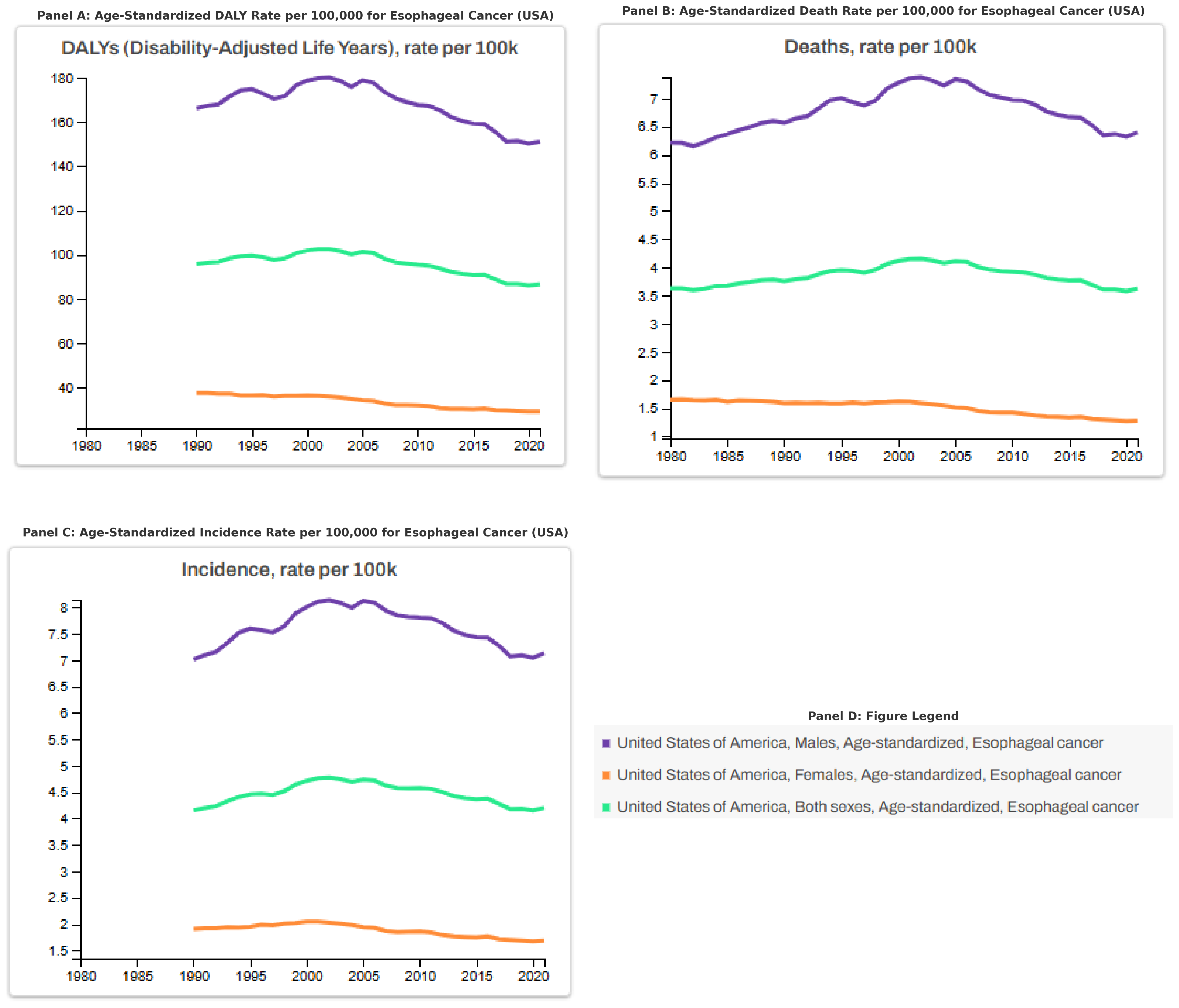Sunday Poster Session
Category: Esophagus
P0652 - Esophageal Cancer in the United States: Three Decade Trends in Age-Standardized DALYs, Mortality, and Incidence Rates (1990-2021)
Sunday, October 26, 2025
3:30 PM - 7:00 PM PDT
Location: Exhibit Hall

Mohamed B. Elnaggar, MD
Hartford Healthcare
Hartford, CT
Presenting Author(s)
Mohamed A. B. Elnaggar, MD1, Mohammed Y. Youssef, MD2, Ayah Obeid, MD3, Ismail Elkhattib, MBBCh4
1Hartford Healthcare, Hartford, CT; 2Hunt Regional Medical Center, Greenville, TX; 3St. Luke's University Health Network, Bethlehem, PA; 4University of Nebraska, Hartford, CT
Introduction: Esophageal cancer is a highly fatal malignancy with poor survival rates. While global trends show regional variability, the U.S. has experienced shifting incidence and mortality patterns. This study evaluates national trends in esophageal cancer burden, focusing on age-standardized disability-adjusted life years (DALYs), death rates, and incidence by sex. to assess temporal trends in the age-standardized burden of esophageal cancer in the United States from 1990 to 2021 using GBD data, stratified by sex.
Methods: We used data from the Global Burden of Disease Study (GBD 2021) to extract age-standardized DALY rates, mortality rates, and incidence rates for esophageal cancer in the U.S. from 1990 to 2021. Data were stratified by sex (males, females) and overall population (both sexes). Trends were analyzed using visual inspection and average annual percent change (AAPC).
Results: From 1990 to 2021, males consistently exhibited the highest age-standardized DALY rates for the condition, peaking around 2000–2005 and declining from approximately 175 to 150 per 100,000. In contrast, females had significantly lower DALY rates, dropping from about ~35 to ~25, while the combined rate for both sexes declined modestly from 98 to 88 per 100,000. Mortality rates followed a similar pattern, with the highest rates in males (decreasing from ~7.0 to 6.2), intermediate rates for both sexes (~4.0 to 3.5), and the lowest in females (~1.6 to 1.3), with all groups showing gradual improvement beginning in the early 2000s—likely reflecting better treatment and earlier detection. Incidence rates peaked in males at around 8 per 100,000 in the early 2000s, declining to 7 by 2020, while female rates remained low and relatively stable (~2.0 to ~1.7); overall, the combined incidence rate fell from about 4.6 to 4.0 per 100,000.
Discussion: From 1990 to 2021, the burden of esophageal cancer in the United States has shown a gradual decline in age-standardized DALYs, mortality, and incidence, particularly among males. These improvements may reflect better management strategies, lifestyle modifications, and advances in surveillance. However, persistent sex disparities highlight the need for targeted public health efforts and early detection strategies.

Figure: Trends in age standardized DALYs (Panel A), Mortality (Panel B), Incidence rates (Panel C) per 100k of Esophageal cancer using GBD database (1999-2021)
Disclosures:
Mohamed A. Elnaggar indicated no relevant financial relationships.
Mohammed Y. Youssef indicated no relevant financial relationships.
Ayah Obeid indicated no relevant financial relationships.
Ismail Elkhattib indicated no relevant financial relationships.
Mohamed A. B. Elnaggar, MD1, Mohammed Y. Youssef, MD2, Ayah Obeid, MD3, Ismail Elkhattib, MBBCh4. P0652 - Esophageal Cancer in the United States: Three Decade Trends in Age-Standardized DALYs, Mortality, and Incidence Rates (1990-2021), ACG 2025 Annual Scientific Meeting Abstracts. Phoenix, AZ: American College of Gastroenterology.
1Hartford Healthcare, Hartford, CT; 2Hunt Regional Medical Center, Greenville, TX; 3St. Luke's University Health Network, Bethlehem, PA; 4University of Nebraska, Hartford, CT
Introduction: Esophageal cancer is a highly fatal malignancy with poor survival rates. While global trends show regional variability, the U.S. has experienced shifting incidence and mortality patterns. This study evaluates national trends in esophageal cancer burden, focusing on age-standardized disability-adjusted life years (DALYs), death rates, and incidence by sex. to assess temporal trends in the age-standardized burden of esophageal cancer in the United States from 1990 to 2021 using GBD data, stratified by sex.
Methods: We used data from the Global Burden of Disease Study (GBD 2021) to extract age-standardized DALY rates, mortality rates, and incidence rates for esophageal cancer in the U.S. from 1990 to 2021. Data were stratified by sex (males, females) and overall population (both sexes). Trends were analyzed using visual inspection and average annual percent change (AAPC).
Results: From 1990 to 2021, males consistently exhibited the highest age-standardized DALY rates for the condition, peaking around 2000–2005 and declining from approximately 175 to 150 per 100,000. In contrast, females had significantly lower DALY rates, dropping from about ~35 to ~25, while the combined rate for both sexes declined modestly from 98 to 88 per 100,000. Mortality rates followed a similar pattern, with the highest rates in males (decreasing from ~7.0 to 6.2), intermediate rates for both sexes (~4.0 to 3.5), and the lowest in females (~1.6 to 1.3), with all groups showing gradual improvement beginning in the early 2000s—likely reflecting better treatment and earlier detection. Incidence rates peaked in males at around 8 per 100,000 in the early 2000s, declining to 7 by 2020, while female rates remained low and relatively stable (~2.0 to ~1.7); overall, the combined incidence rate fell from about 4.6 to 4.0 per 100,000.
Discussion: From 1990 to 2021, the burden of esophageal cancer in the United States has shown a gradual decline in age-standardized DALYs, mortality, and incidence, particularly among males. These improvements may reflect better management strategies, lifestyle modifications, and advances in surveillance. However, persistent sex disparities highlight the need for targeted public health efforts and early detection strategies.

Figure: Trends in age standardized DALYs (Panel A), Mortality (Panel B), Incidence rates (Panel C) per 100k of Esophageal cancer using GBD database (1999-2021)
Disclosures:
Mohamed A. Elnaggar indicated no relevant financial relationships.
Mohammed Y. Youssef indicated no relevant financial relationships.
Ayah Obeid indicated no relevant financial relationships.
Ismail Elkhattib indicated no relevant financial relationships.
Mohamed A. B. Elnaggar, MD1, Mohammed Y. Youssef, MD2, Ayah Obeid, MD3, Ismail Elkhattib, MBBCh4. P0652 - Esophageal Cancer in the United States: Three Decade Trends in Age-Standardized DALYs, Mortality, and Incidence Rates (1990-2021), ACG 2025 Annual Scientific Meeting Abstracts. Phoenix, AZ: American College of Gastroenterology.
